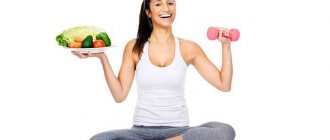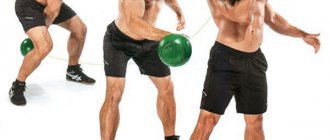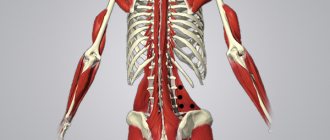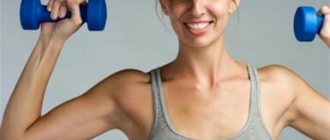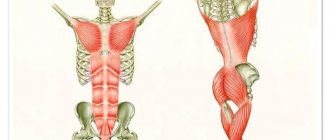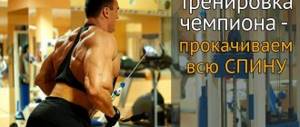Author: Timko Ilya - the ruler of the entire site and fitness trainer | more details >> Rod. 1984 Trained since 1999 Trained since 2007. Author and creator of the site tvoytrener.com. CCM in powerlifting. Champion of Russia and South Russia according to AWPC. Champion of the Krasnodar region according to IPF. 1st category in weightlifting. 2-time winner of the Krasnodar Territory championship in t/a. Author of more than 700 articles on fitness and amateur athletics. Author and co-author of 5 books.
Place in the author rating:
out of competition
(become an author) Date: 2012-05-29 Views: 348,807 Rating: 5.0
| Silver medal: | |
| 1. The article is in the TOP 50 2. The article has more than 3. The article has more than 500 | |
| Gold medal: | |
| 1. The article is in the TOP 10 2. The article has more than 1 3. The article has more than 1,000 | |
Main muscles - gastrocnemius Additional - soleus Difficulty - easy
Anatomy of the lower leg
The human body is amazing: tissues and structures of different composition, qualities, functions are combined into an indivisible whole. But during a massage, it is still worth taking into account the uniqueness of each forming element in order to choose the right methods of influence, which are sometimes very different. And here a massage therapist cannot do without knowledge of anatomy.
When working on the lower leg, you need to remember that it is based on two bones - the tibia and tibia, connected to each other by a dense membrane. They are surrounded by three muscle groups:
- Lateral - the long and short peroneal muscles included here lift the outer edge of the foot, and are also responsible for its correct installation, strengthening the longitudinal and transverse arches.
Photo. Calf muscles: lateral group. - Anterior, consisting of the tibialis muscle and two long extensors, one of which controls the big toe, and the second controls all the others. These structures allow the movement of the foot, but provide little or no protection to the bones. This is why injuries to the front of the shin are very painful.
Photo. Anterior muscle group of the lower leg. - The back, consisting of two layers. The deep one is represented by the popliteus, posterior tibial muscles and two flexors of the fingers, the superficial one - by the plantar and triceps muscles. All of them allow you to rotate your foot in different directions and bend your lower leg.
Photo. Calf muscles: posterior group.
The massage therapist must remember that this area contains the most important blood vessels, ligaments and tendons, and the most powerful of them is the Achilles. The innervation of the lower leg area comes from the tibial and peroneal plexuses, which provide high tissue sensitivity.
The triceps muscle, in turn, consists of the soleus and gastrocnemius. The latter is of particular interest to massage therapists. It provides all movements of the ankle with straightened legs, stabilizes the position of the lower extremities when running and walking. This largest of the superficial muscles of the posterior group is more susceptible to illness, injury, and sprains than others. Even in absolutely healthy people, stress points periodically appear in this part of the leg, which are easily eliminated by massaging the lower leg muscles.
Effective exercises
There are several most effective sets of exercises designed specifically to work the lower leg muscles:
- Walking on your toes is a great way to develop the inner part of the calf muscle. You need to stand up straight, rise on your toes and walk around the room in small steps. The duration of the exercise is not limited, do this exercise as much as you can. You can walk on your toes not only at home, but also at work, while walking, etc.
- Calf raises – develop and help maximally work the soleus muscle. Starting position - standing with your legs wide apart, slightly bent, your hands should rest on the back of the chair. Lower your heels as much as possible and try to rise on your toes as high as possible. After execution, there is noticeable tension and slight soreness in the calf area.
- Seated leg raises are an exercise that helps work all muscle groups of the lower leg. Sit on a chair, place support under your feet. Slowly raise the toe of 1 foot until you feel extreme tension in the ankle area. The optimal number of repetitions is about 15-20.
- Raises on 1 leg with support on a chair. To perform this exercise, you need to place one foot on the floor and keep the other in weight, moving your toe to the support. Continue lifting until you feel extreme tension, the so-called highest point, and then slowly lower down until you feel a slight stretch in the calf muscle. Take a short break and repeat the actions with the other lower limb. Do 10 repetitions.
- Jumping from a deep squat is a productive way to pump up your lower leg muscles. Sit down as deep and low as possible, pick up dumbbells and try to jump high out of the position. Lower yourself onto your toes, then return to the starting position. It is recommended to perform the exercises in 3 trips, doing 10–15 jumps during each of them.
- Squats with high heels will give excellent results even without the use of weights. Bend your knees and squat deeply, raising your heels up. The main support lies on the toes. It is recommended to do 30 repetitions over 3 sets.
- Jumping rope is a simple but effective exercise. You can do it at home, as long as you have enough space. Taking a jump rope in your hands, actively jump over it. Make jumps extremely high and intense. Continue until an internal burning sensation appears in the calf muscles.
- Exercise "pistol". To perform this you will need support. Holding it with your hand, stretch your leg forward, and with the other limb do squats as deep as possible.
- Simple level springs - pump up the muscles of the lower leg well. You need to stand up straight and slowly, smoothly rise onto your toes. After reaching the maximum point, lower yourself down, but make sure that your heels do not touch the floor. Repeat 10–15 times.
- Complicated springs - you can increase the effectiveness of the previous exercise and increase muscle volume by using additional weights - pick up dumbbells and hold them during the lifting process.
These exercises, when done regularly and correctly, will help you make progress.
Variety of techniques
The choice of technique and techniques for influencing this part of the leg is very individual. It depends on the current situation, age and health of the patient. Taking into account the above criteria, several types of massage are distinguished.
Sports
We inherited this technique from the ancient Olympians. In preparation for jumping competitions or running, they actively stretched their calves, trying to give strength and endurance to their legs. Nowadays athletes also cannot imagine their life without massage. It becomes an integral part of their daily regimen, used before and after training and sports competitions. The technique combines superficial effects with deep ones:
- warms up the body;
- stimulates the production of acetylcholine, a substance that increases endurance and performance of muscle fibers;
- relaxes;
- relieves pain;
- rehabilitates the body after heavy loads and injuries, normalizes clogged muscles;
- strengthens the musculoskeletal system;
- increases joint mobility;
- improves the physical qualities of the body.
Sports massage can be preliminary, restorative or training. Each technique considers the impact on the calves as an independent procedure or an essential element of a general massage. It is based on basic techniques, and the execution time depends on the type of procedure and the state of the athlete’s body and ranges from 5 to 60 minutes.
Classical
This technique is used when you need to relax the limbs, relieve muscle tension, get rid of pain, increase the mobility of the lower leg, feet, knee joint, and prevent diseases of the musculoskeletal system and varicose veins. Often the calf muscle is not worked separately, but as one of the zones during a general leg massage. In this case, the effect is first on the thigh (we have already discussed the techniques in detail in the article: “Massage of the thighs”), and then on the lower leg and foot: “Massage of the feet.”
The massage therapist uses techniques that become basic in therapeutic, sports or hygienic massage:
- stroking;
- squeezing;
- trituration;
- kneading;
- compression;
- pressing;
- wallow;
- chopping;
- sawing;
- pat;
- shaking.
During the massage, you need to control the pressure. Light has a relaxing effect, medium improves blood circulation and removes excess fluid, and excessive can lead to cramps due to increased sensitivity of the calf muscles.
Children's
Every child needs to massage their feet from one and a half months.
- For healthy babies, this is a great way to overcome physiological hypertonicity, relax tense muscles and straighten limbs. This increases joint mobility and increases the child’s motor ability.
- Since the muscles of the lower leg control the installation and movement of the foot, supporting its longitudinal and transverse arch, massaging this area becomes a good prevention of rickets, valgus, varus and flat feet.
- The procedure prepares the child's body for crawling, standing and walking by strengthening muscles and developing joints.
- Activation of blood circulation, lymph flow and metabolic processes improves the baby’s well-being and strengthens his immune defense.
- Massaging the baby's feet eliminates existing foot deformities, which avoids surgical intervention. The main thing is to pay attention to the problem in time.
Infants are recommended to have a daily general massage with the obligatory work of the calf muscles with light superficial movements: stroking and squeezing. When the child grows up a little, gentle rubbing, kneading, and pinching are added.
Children's skin is thin and delicate. In order not to injure it, all movements are performed with the fingertips without unnecessary effort. It must be remembered that in the popliteal fossa there is a sensitive plexus that innervates the calf muscle, so massaging this area is prohibited.
Osteopathic
The procedure is considered therapeutic and diagnostic. By palpating the patient's body, the specialist finds problem areas and acts on them in a special way. As a result of working with the musculoskeletal system, not only muscle tone is normalized, ligament blockage is removed, the position of bones is corrected and the range of motion of joints increases. First of all, the root cause of pathological changes is eliminated; protective mechanisms of self-regulation are launched in the human body, aimed at restoring lost functions. Various techniques are used for this:
- Fascial. The osteopath gently, without sharp shocks and jerks, acts on the thin muscle membranes. This way, spasms and tension in the tissues go away, their tone is normalized, a noticeable lymphatic drainage effect appears, the position of the joints and bones is corrected, and the mobility of the joints returns.
- Muscle-energy. Normalizes the condition of the muscles, relieving them of spasms, tension or weakness. The patient actively participates in the procedure, tensing the muscles as much as possible. The osteopath begins his work at the relaxation stage, providing a deep but painless effect.
- Soft tissue: during a massage, the specialist does not just rub and knead the problem area, but looks for pathological changes: spasm, swelling, limited mobility. By exerting light pressure on internal structures, straightening tendons, and acting in a certain rhythm on the fascial membranes, it eliminates existing problems.
- Articular: examining the joint, the specialist feels for clamped and blocked areas. Controlling the position of the joint with one hand, he performs rhythmic tractions of small amplitude with the other. These actions gradually normalize the position of the joint, develop its mobility, and stimulate the production of natural joint lubricant - synovial fluid.
According to osteopaths, it is necessary to take care not only of a person’s body, but also of the state of his mind and spirit. Such unity is the basis of good health.
Workout plan
To pump up the calf muscles, it is recommended to exercise 3 times a week for six months.
Before training, be sure to warm up and pay attention to the following rules:
- take short breaks between approaches (1 minute each);
- give regular, systematic physical activity;
- gradually increase the number of approaches and complexity of exercises;
- adhere to the execution technique.
Author's techniques
Some techniques have been known to man for hundreds of years. They are still used as basic techniques for different types of massage, supplementing, changing, adapting to each specific situation. This is how effective proprietary techniques emerge that are worthy of being considered classic.
Znamensky's technique
Rostislav Znamensky is a renowned sports massage therapist and physiotherapist with extensive experience in preparing track and field athletes for competitions and their return to training after serious injuries. The main load when running and jumping falls on the leg muscles, so the master created a whole system to restore their full functionality.
In the case when the calf muscle has become dense and tense, “clogged,” as athletes say, Znamensky recommends proceeding according to the following scheme:
- Warm up the problem area by wrapping a heating pad with an elastic bandage for 20 minutes.
- Stroke, knead and rub the calves.
- Do a deep massage of the top layer of skin.
- Stretch the muscle in segments. To do this, the athlete, lying on his stomach, bends his foot towards himself, straining his lower leg. Pressing movements with the palm are carried out at the moment of relaxation. Do the same using the strength of your forearm.
- Wrap the surface with an elastic bandage.
- Stretch your foot.
A gentle relaxing calf massage will help you completely forget about the problem the very next day.
Methodology of Vladimir Gushchin
The technique of this massage therapist has an excellent relaxing and healing effect, and is used for the rehabilitation of patients after injuries, fractures, for the purpose of losing weight, reducing fat deposits and swelling. He combines the impact on the muscles of the back of the lower leg with mandatory work on the feet and rubbing of the Achilles tendon. The technology of this master is based on techniques such as:
- stroking;
- sawing, crossing;
- kneading;
- ironing;
- vibration;
- shaking.
You can learn more about them by watching the training video:
Self-massage technique
Pain and spasms in the calves can overtake any of us. You can quickly eliminate, or even better prevent, unpleasant manifestations with the help of self-massage at home.
Preparatory procedures
In emergency cases, you can stretch the calf muscle in any conditions directly through clothing. But the effect will be greater if you first:
- ventilate the room in which you plan to carry out the procedure;
- take a shower;
- do a warm-up - a few simple exercises to stretch the muscles of the back of the lower leg (for example, sitting on the floor, throw a jump rope over your foot, and, raising your leg, hold this position for a count of five);
- remove jewelry from your hands and cut your nails short;
- apply massage oil or anesthetic cream to the skin (if there is severe hair growth in this area, it is better to use talc).
Try to completely relax, tune in to the positive, and only then proceed directly to the procedure.
What techniques to use
You can stretch your muscles with the help of a massager, but nothing can replace the strength, warmth and energy of your hands, so you should turn to manual self-massage after watching several video tutorials or reading training manuals. Sit with your foot on the bench, bend your knee. Perform all movements from the base of the shin upward, along the lymphatic flow. Avoid discomfort and pain.
- Start the massage traditionally with stroking. With your palm on the calf muscle so that your thumb is opposite the rest, move your hand freely, being careful not to displace the skin. Perform the same movements with both hands alternately.
- Do squeezing (stroking with pressure) with your fingers closed and folded in the shape of a beak.
- Rubbing involves influencing the deep layers. In this case, the hand does not slide over the skin, but displaces it. Use the pad of your thumb to “draw” a Christmas tree. Perform longitudinal, transverse, circular or spiral movements with the phalanges of half-bent fingers or the base of the palm.
- Kneading is a massage technique in which the muscle is grabbed, lifted, and then slightly pulled to the side.
- Effleurage - rhythmic blows that are performed across the fibers with different parts of relaxed hands.
- Shaking – Grasp the muscle and shake it with quick, oscillating movements.
Intersperse all basic techniques with stroking. The massage lasts about 10 minutes. But even this gives tangible results: the legs stop hurting, spasms, heaviness and tension go away.
Warming up and stretching
Before performing exercises for the calf muscles, pre-warming and stretching are required, which will increase the effectiveness of the training and help avoid traumatic injuries and micro-tears.
To warm up, you can use the self-massage technique. Rub the area of the ankle, ankle, foot.
The following types of exercises are suitable for stretching:
- One leg swing. Lean against the wall, the back of the chair, place 1 limb on the floor, and swing the 2nd limb, trying to raise it as high as possible. The recommended number of repetitions is 15 times for each leg.
- Lunges. Standing straight and straight, place your feet side by side, then take one step forward with one foot and smoothly transfer your body weight to it. Hold in this position for at least 10-15 seconds, then repeat with the 2nd limb.
- Stretching. Sitting on the floor, spread your legs to the sides and try to move your torso and stomach towards your hips as much as possible. The recommended number of repetitions is 5-6 times.
Warm-up, stretching, and warming up will make your joints mobile and your muscles strong and resilient.
Prices
Moscow salons offer several types of massage, including working the calf muscles:
- general (1500–2000 rubles per hour and a half);
- relaxing (700 rubles for 60 minutes);
- foot massage (600 rubles for 45 minutes);
- massage of calves and feet (400 rubles for 20 minutes).
The benefits of each of these techniques are undeniable. In any case, massage will be a worthy alternative to drug or surgical treatment, will support the health of your legs, give ease of movement and a good mood.
How to reduce calves on your legs
Sometimes it is necessary to reduce the volume of the calf muscles. More often, this problem occurs in women who are actively involved in sports, cycling, running, and athletics. To achieve these goals, stretching the calf muscle will be effective.
It is recommended to sit down, straighten your legs, and pull your toes towards you. Stay in this position as much as possible, return to the starting position and pull your toes away from you. The force load on the lower limbs should be extremely limited. Methods such as cosmetic procedures and diet therapy will also help solve the problem.
Changing dietary principles
No special diet is required to reduce calf muscles. But trainers recommend reconsidering, changing nutritional principles, and reducing the percentage of protein foods in the diet as much as possible. The basis of the daily menu should be fresh vegetables, fruits, herbs, fermented milk products, bran, and grains.
Massage
It will help reduce the volume of calves with swelling or accumulation of subcutaneous fat deposits. For these purposes, both manual, manual, and hardware techniques are used. Massage helps normalize blood circulation, the outflow of blood and lymph, and the breakdown of subcutaneous fat. The number of sessions is determined individually.
Wraps
They also help slim your calves. Hot wraps have a good effect because they:
- raise the local temperature to 38° C;
- stimulate blood circulation;
- activate metabolic processes;
- promote fat burning.
The procedure has contraindications, so it is better to consult a doctor before performing it. It is recommended to have body wraps done in a salon by a good professional, without experimenting with folk recipes.


